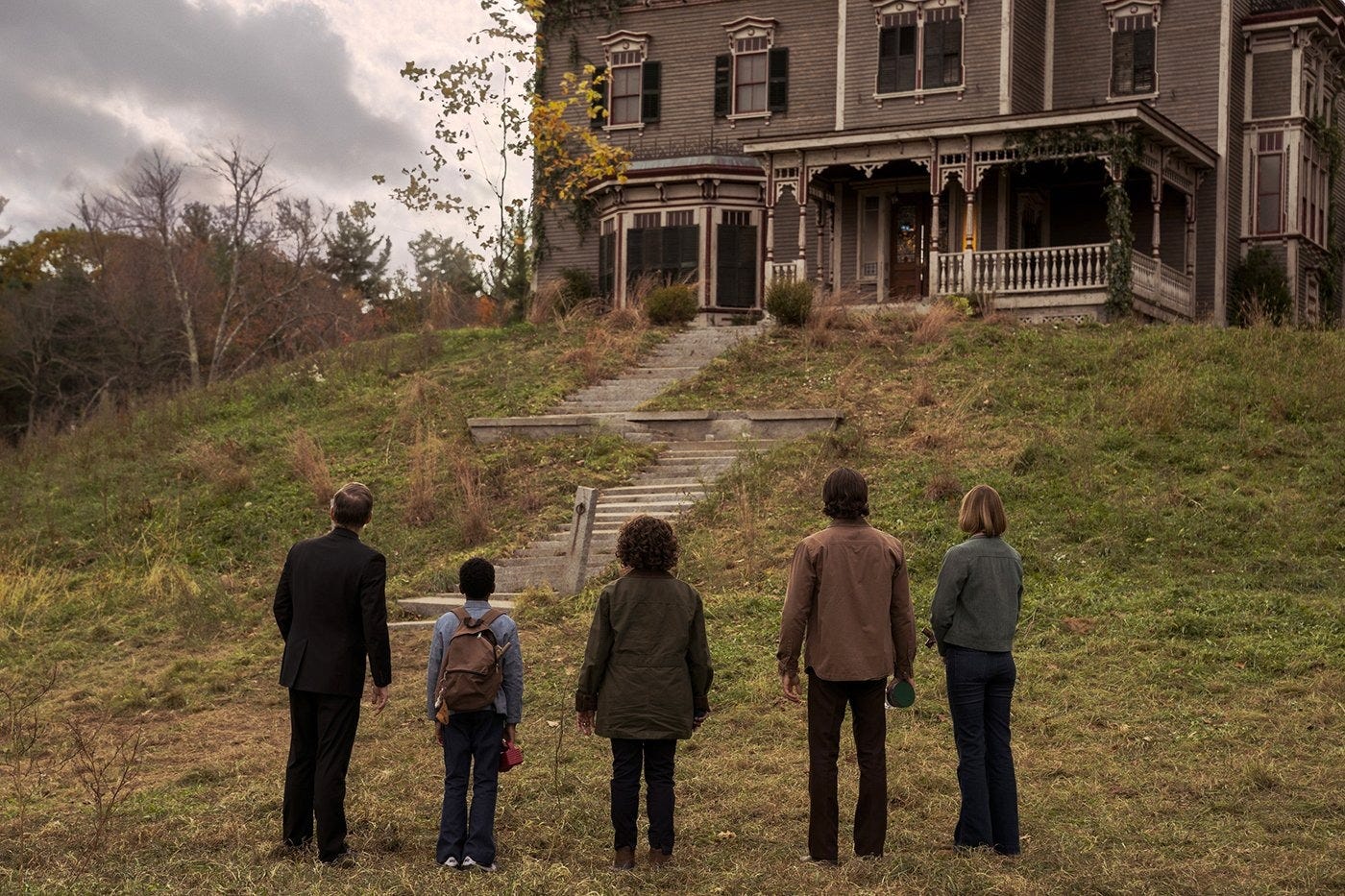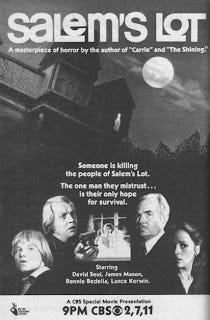New & now: Salem’s Lot
Stephen King's classic vampire novel is condensed to the tiniest bite-sized cube.
I probably wouldn’t be the horror fan I am today if I didn’t have excessively (if not dangerously) permissive parents.
I don’t mean that in a Gen X “my parents used to send me to the store to buy cigarettes” way (though they did that too), I mean that there were no limits on what I could read or watch, save for two from my father: (1) Three’s Company (because he thought it was stupid1), and (2) The Day After (because he thought it would make me anxious2). Everything else was A-OK. My mother let me stay up late to watch Saturday Night Live with her when I was too young to get most of the jokes. My father let me leaf through his copies of National Lampoon, also when I was too young to get most of the jokes. Nothing was really forbidden, even if it should have been.
The first adaptation of Stephen King’s Salem’s Lot aired near the end of 1979, which would have made me all of 7 at the time. A bit young to watch a movie about a vampire decimating a small town, starting with a child not much older than me? Probably! But Gene and Celeste didn’t seem to think so, and I was not told to go to bed before they turned it on.
Salem’s Lot wasn’t the first horror movie I had seen, but it was the first one that both terrified and fascinated me. The now-iconic scene of little Ralphie Glick hovering outside his brother’s window in his jammies became a pivotal moment in my love for horror, even if it caused me to lose sleep at the time. I don’t think before that point I had ever considered the existence of vampires, but I sure as hell did afterward, and it was honestly sort of exhilarating. I discovered that I enjoyed that exhilaration. It’s a testament to how effective a fog machine, some wire work, and reflective contact lenses can be.
I revisit the miniseries from time to time. While it’s not perfect (and Fred Willard playing the town loverboy in silk boxer shorts is hilarious, even if it’s not supposed to be), I have a lot of affection for it. Tobe Hooper, working with Paul Monash’s screenplay, hewed as close as he could get to the book (which is an unequivocal masterpiece, and I shall not hear differently) despite the time and ratings limitations. It doesn’t fall into the same trap as so many other film and TV adaptations of Stephen King stories do, where so much is either taken away or added that it barely resembles the source material. Salem’s Lot is one of King’s most straightforward, un-weird books (as opposed to, say, Rose Madder), and shouldn’t be challenging to bring to life on a screen.
Yet, a 2004 TNT miniseries adaptation was lackluster at best, and saved mostly by its supporting cast, including Andre Braugher as schoolteacher Matt Burke, James Cromwell as Father Callahan, and Rutger Hauer as the vampire Barlow, looking human as he does in the book, rather than Reggie Nalder’s Nosferatu-like version in the Hooper version. And now, we have 2024’s feature-length version, for which “lackluster” would be an improvement.
When a third version of Salem’s Lot was announced in 2019, it was met with the usual “oh boy, here we go” skepticism that most Stephen King adaptations are met with, which is understandable because the vast majority of them are dreadful. And yet the news that Gary Dauberman, who wrote The Conjuring and co-wrote the far-better-than-expected It Chapter One, was attached to it sounded promising. Dauberman also wrote the worst Annabelle movie in the series, and It Chapter Two, but eh, details.
Salem’s Lot had been scheduled for a 2022 theatrical release, then pushed back, like many movies in the same period, due to the impact of COVID-19 on the film industry. Then it was quietly pushed back a few more times, and puzzlingly there was no trailer, or even production stills made publicly available. There were rumors that a clip had been screened at the 2023 San Diego Comic-Con, but no evidence that that was actually true. A full five years after the project was announced, there was still no clear release date, other than a vague “sometime in 2024.”
Just when it seemed like it might go the way of Batgirl and Coyote v. Acme, buried in David Zaslav’s backyard and never to be seen by human eyes, it was revealed that Salem’s Lot was bypassing theatrical release and going directly to Max. Finally, a month before its release, a trailer was available and it looked…pretty good! There was nothing indicating why it appeared that Warner Bros. was considering burying the whole thing before just dumping it onto streaming for the Halloween season instead. It looked like an adaptation of Salem’s Lot with some 21st-century shine on it.
And, well, anyway. Gary Dauberman also wrote the worst Annabelle movie in the series, and It Chapter Two.
I’m assuming the average reader of this newsletter knows the general plot of Salem’s Lot, so I shan’t explain it here, and it doesn’t matter anyway because this version does away with about 90% of it. The story is so stripped down to its most salient points that you wouldn’t even know it was a Salem’s Lot adaptation if not for the fact that the movie starts and ends with a shot of a road sign reading SALEM’S LOT.
When we first meet hero Ben Mears (Lewis Pullman), he’s in his car staring warily at the Marsten House, a decaying mansion just outside of his old hometown. Clearly there’s something troubling him about it, but we never find out why, even though it’s a major plot point in the book. There, the Marsten House is practically a character in itself, looming over everything like a dark idol. Many of King’s best novels, including Pet Sematary and It, explore the concept of a place existing on “sour ground,” and so too does Salem’s Lot. Barlow doesn’t just choose to live in the Marsten House because it was available, but because it’s a bad place, in a town that’s already dying on the vine, full of people whose bland, neighborly facades hide the fact that they’re drunks, wife beaters, and perverts. It’s ripe for the picking, as it were.
But exactly none of that is present in this adaptation. A guy comes to town at almost exactly the same time as a vampire starts picking off the townspeople one by one, and it’s up to him to get a ragtag team together to defeat evil. That’s it.
Now, in Dauberman’s defense, his original cut of the film was reportedly three hours long, and chopped almost in half to an hour-fifty. Perhaps all the plot and character development is in that missing 70 minutes, because God knows it isn’t here. However, it doesn’t explain how it looks like it was edited by someone who won a contest in which the prize was the chance to edit Salem’s Lot.
A movie shouldn’t make you wonder if you’ve blacked out for several minutes and missed who certain characters are, or if they’re still alive or not. And yet, people get a line of dialogue (or are at least pointed out and named), and then never show up again. It seems like Floyd Tibbets, who gives Ben Mears an awful lot of trouble in the book, might have something to do, but he’s shown in exactly one (1) scene glowering at him, and then for all we know he falls into a river or takes off for the Poconos. Up until nearly the end of the movie, it appears that Mark (Jordan Preston Carter), an 11 year-old, doesn’t have parents, until they finally show up and are almost immediately killed.
The pacing is so rushed that it jumps from “Here’s a vampire” to “And now everyone is dead” in about ten minutes. It’s figured out far too quickly what’s going on, and characters know things they shouldn’t know yet. Instead of showing a montage of vampirism spreading like a disease throughout the town (which is one of the most haunting passages in the book3, and would have worked especially well now in the COVID era), a character we’ve never seen before and never see again simply remarks “Seems like you can’t get a hold of anyone in the Lot these days.”
These days? What days? How many days? It’s never clear. But that part isn’t Dauberman’s fault. What is Dauberman’s fault is the ending, a showdown at the local drive-in that suggests that head vampire Barlow isn’t a very effective planner. As opposed to the ambiguous “We’re safe now, but more will be coming for us” ending of the original, things conclude on a weirdly upbeat “Job well done, it’s Miller Time” note. A whole town has just been decimated, so to have the survivors practically high-five each other as they’re driving away is a curious choice at best.
Are there things to like about Salem’s Lot? Sure. Bill Camp is in it, I like him. Alfre Woodard is in it, I like her. Lewis Pullman is fine, and I couldn’t help but think that his father, Bill Pullman, would have been a great Ben Mears 30 years ago or so. I liked the fact that crosses glow in the presence of a vampire; unsurprisingly that was taken directly from the book. I liked the scene in which Mark hides in his treehouse from a bunch of vampire kids. I liked that they used Gordon Lightfoot’s “Sundown” on the soundtrack. I liked that it made me want to read the book again, and fill in all the gaps the movie inexplicably leaves behind, like why anyone should care about why any of this is happening. That’s important if you want anyone to remember your movie for any longer than it takes to watch it.
He wasn’t wrong, and yet I was allowed to watch The Dukes of Hazzard.
The joke was on him, I had already been anxious for years.
Sandy McDougall trying to feed her dead baby chocolate pudding will chill me forever.






King's strongest writing is, as you said, creating a real sense of place, how the sun hits a storefront, the feel of a breeze on the way home from school. This adaptation had none of that, this town was framed as just that lone street with no depth or character. They mention the town is dying yet we see no physical evidence, the drive in gets robust business, the school seems to be full. The rot that should be permeating is never felt.